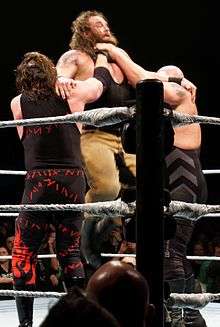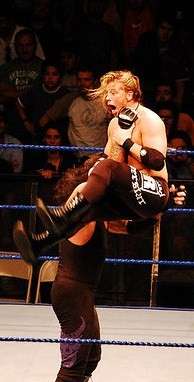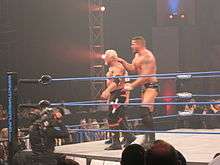Chokeslam
A chokeslam is a type of body slam in professional wrestling, in which a wrestler grasps an opponent's neck, lifts them up, and slams them to the mat. It is common in televised wrestling because it is simple and relatively safe, yet looks powerful on camera. The chokeslam is typically used as a finisher by large wrestlers, further enhancing its perception as a powerful maneuver. This maneuver can be more damaging if the victim is slammed into an object, such as a table, steel chair, or garbage can. It is a common move performed by taller and bigger wrestlers.
The most common variety of chokeslam is performed with a single-handed choke. The wrestler places their free hand behind the opponent's back or hooks the trunks to help turn them horizontally for the throw. Although a chokeslam begins with a "choke", it is not usually considered to be an illegal move. The single arm choke that normally precedes a chokeslam is known as a goozle.
The chokeslam was innovated by Paul Heyman for use by the wrestler 911,[1] though one of the earliest accounts of the move dates back to a 19th-century recounting that describes Abraham Lincoln (himself a wrestler in his youth) using a technique very similar in description.[2] It is often used by large, powerful wrestlers such as The Undertaker, Kane, The Big Show, Abyss, The Great Khali, Vader and Braun Strowman. This is because a larger, taller wrestler will be able to deliver a much higher, more impressive chokeslam than most smaller wrestlers. Their height and/or larger frames can also give them extra time to correct a botch if something goes wrong. However, some smaller wrestlers and even female performers have used the chokeslam, including Lacey Von Erich, The Hurricane, among others.
Variations
Back suplex chokeslam
In this elevated chokeslam, innovated by Akira Taue, the wrestler stands behind the opponent, puts his head under one of the opponent's arms, and lifts them onto his shoulder. The wrestler then pushes the opponent upwards, turns 180°, and grabs hold of the falling enemy's throat, driving them down to the mat back first.
Chokeslam backbreaker
The wrestler performing the move stands in front of and slightly to the left of the opponent receiving it. The wrestler then reaches out and grabs the opponent's throat and trunks, and lifts him or her in the air as though the wrestler is about to deliver a chokeslam. However, as the wrestler brings the opponent back down to the mat the wrestler kneels, slamming the other wrestler's back onto his or her extended knee. This move is popularly known as a chokebreaker/choke breaker, which is a portmanteau of this move's technical name.
Double chokeslam

When two wrestlers execute a chokeslam on a single opponent at the same time it is referred to as a double chokeslam. Due to convenience of wording, a double chokeslam can also refer to two chokeslams being performed by a single wrestler on two opponents at the same time (i.e. single person double chokeslam), and occasionally in a tag team match where each member of one team will chokeslam a member of the opposing team (i.e. simultaneous / stereo chokeslams) which can also be referred to as stereo chokeslams.
The traditional version is also referred to as a double spinebuster/double front slam as the action of lifting an opponent up and throwing them down are much the same, though the spinebuster and front slam are more common on a charging opponent.
Inverted powerslam chokeslam
Like the vertical suplex chokeslam, but in this variant, the attacking wrestler puts the opponent in a powerbomb position and lifts them up in an inverted powerbomb. The wrestler moves his arm from around the opponent's neck, grabbing hold of their throat. The wrestler then slams the opponent down to the mat back first.
Leg trap chokeslam
Also known as a Leg hook chokeslam, or the Sky High Chokeslam, as dubbed by Vader, the attacker starts out by lifting the opponent's left or right leg off the ground and tucks it under or hooks it over their arm while using whichever free hand to grab the opponent's neck. Then, the attacker lifts the opponent into the air and slams the opponent down to the mat. The move can also be used as a reversal from when the opponent tries some form of kick only to have the attacker catch and hold on to the leg setting up the move from there. A sitting version and a kneeling version are also possible.
One-handed chokeslam

A very common variation, usually performed by a larger wrestler to a smaller one, this move sees the usual execution of the chokeslam done with just one hand lifted from the throat without the support of the other hand that usually goes on the back. The Big Show, Kane, and The Undertaker frequently perform this. The Big Show invented the kneeling chokeslam during his time in WCW under the name The Giant from 1995-1999.
Reverse chokeslam

The attacking fighter grabs hold of an opponent's neck with both hands, one on the front, and one on the back. The arm that has the hand on the back of the neck may hook the opponent's arm. The wrestler then lifts the opponent up, releases the hand holding the front of the opponent's neck, and pushes forward and slams the opponent to the mat face first with the other hand. This is used mainly by Matt Morgan and Braun Strowman.
Reverse impact chokeslam
In this variation the attacking wrestler grabs the opponent's throat with one hand and grabs the opponent's abdomen with his free hand, then the attacking wrestler lifts the opponent over their head and then slams the opponent similar to a vertical suplex chokeslam.
Sitout chokeslam
This variation of a chokeslam is similar to an ordinary chokeslam, however, instead of the wrestler remaining standing, the wrestler falls into a seated position while forcing the opponent back-first into the mat.
Two-handed chokeslam
This move sees a wrestler first grasp an opponent's neck with both hands, then lifting them up and choking them before then throwing the opponent back down to the mat usually after choking out his opponent. A falling version of this move can see the attacking wrestler fall forward to the mat while keeping their arms extended but will more often see the wrestler fall into a seated position or a kneeling position, The Great Khali used this.
Vertical suplex chokeslam
In this elevated chokeslam, innovated by Akira Taue, the wrestler grabs a front facelock on the opponent and wraps their arm over the wrestlers neck or body. The wrestler then lifts the opponent upside down, as in a vertical suplex. The wrestler moves his arm from around the opponent's neck, grabbing hold of their throat. The wrestler then slams the opponent down to the mat back first.
References
- "Tommy Dreamer Explains Why He Will Never Take Another Chokeslam". Archived from the original on 2015-08-10. Retrieved 2015-08-09.
- "Abraham Lincoln: Amazing Wrestler". mental_floss.
External links
![]()